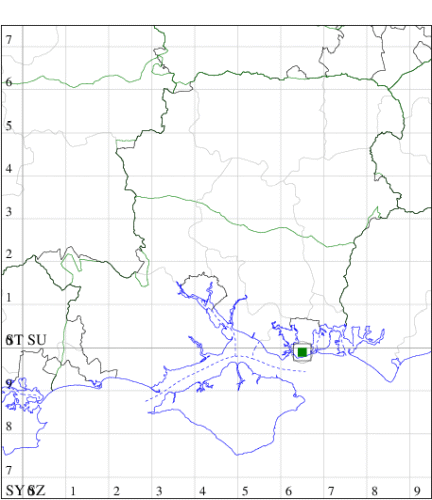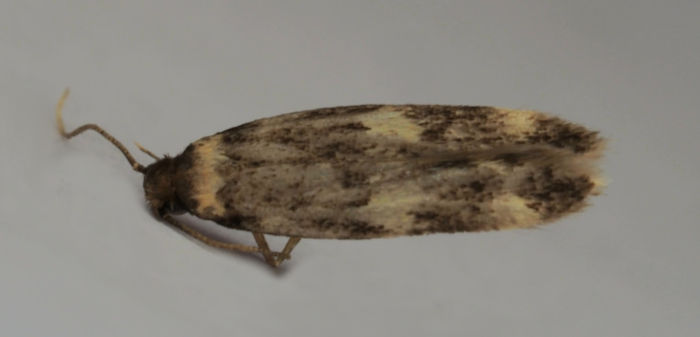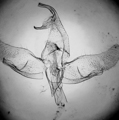Oegoconia novimundi
Checklist Number27.0021 [B&F: 0870a]
Verification
Record requires retention of specimen until confirmed, and may require dissection. Consult with CMR if unsure
Classification
| Family: | Autostichidae |
| Subfamily: | Symmocinae |
| Genus: | Oegoconia |
| Species: | novimundi |
| Authority: | (Busck, 1915) |
Found across mainland Europe from Spain to Greece and the Balkans. Added new to the British list from specimens taken in Middlesex in 2011 and 2015 by Rachel Terry (Ent Rec 128(2)).
Adult markings: The following is based on Busck's original description from 1915. The head is dark fuscous, and the antenna dark fuscous with the apical third pale ocherous. The second joint of the labial palp is dark brown with a yellow apex and inner sides. The terminal joint is dark brown with the extreme tip ocherous. The tips of the tegulae and posterior region of the thorax are light ocherous and together produce a light band near the wing base. The forewings is dark fuscous with three light ocherous marks. The first is a small subcostal spot at about one-fifth the wing length. At one-half, there is a larger spot that often appears as a jagged fascia that extends from the costa to near the inner margin. A third small spot occurs at the apical fourth along the costa, and sometimes has an opposing small dot near the inner margin. The cilia are dark fuscous, and the hindwing light fuscous with whitish fuscous cilia. The abdomen is dark fuscous with a light anal tuft. The legs are dark fuscous with light ocherous annulations at the base of the joints.
Adult structural features: Records will need to be supported by genitalic dissection. Landry et al. (2013) have illustrations of the male and female genitalia, and describe characters that will distinguish this species from O. deauratella. In males, O. deauratella is distinguished from O. novimundi by the indented apex of the uncus, the apex of the sacculus being slightly narrower than the base, the distal portion of the valva not being distinctly narrowed, and the presence of a large patch of densely set, stout spines subapically on the vesica anterad of the terminal bundle of thin spines. In O. novimundi, the apex of the uncus is straight or truncate, the apex of the sacculus is slightly broadened, the distal portion of the valva is slightly narrowed, and the vesica has only a terminal bundle of thin spines. In females, O. deauratella has a smooth-walled ductus bursae with finely spinulose microsculpture, and the signum has a rounded, asymmetrical base and a short terminal spine. In O. novimundi, the ductus bursae has sclerotized wrinkles without microsculpture, and the signum has a subsymmetrical, deeply notched base and a long terminal spine (source Landry et al., 2013).
Wingspan: 12-13 mm
Forewing: 5.5-7 mm
The larvae appear to be detritivores that feed on decaying leaves or other plant debris.
Adult markings: The following is based on Busck's original description from 1915. The head is dark fuscous, and the antenna dark fuscous with the apical third pale ocherous. The second joint of the labial palp is dark brown with a yellow apex and inner sides. The terminal joint is dark brown with the extreme tip ocherous. The tips of the tegulae and posterior region of the thorax are light ocherous and together produce a light band near the wing base. The forewings is dark fuscous with three light ocherous marks. The first is a small subcostal spot at about one-fifth the wing length. At one-half, there is a larger spot that often appears as a jagged fascia that extends from the costa to near the inner margin. A third small spot occurs at the apical fourth along the costa, and sometimes has an opposing small dot near the inner margin. The cilia are dark fuscous, and the hindwing light fuscous with whitish fuscous cilia. The abdomen is dark fuscous with a light anal tuft. The legs are dark fuscous with light ocherous annulations at the base of the joints.
Adult structural features: Records will need to be supported by genitalic dissection. Landry et al. (2013) have illustrations of the male and female genitalia, and describe characters that will distinguish this species from O. deauratella. In males, O. deauratella is distinguished from O. novimundi by the indented apex of the uncus, the apex of the sacculus being slightly narrower than the base, the distal portion of the valva not being distinctly narrowed, and the presence of a large patch of densely set, stout spines subapically on the vesica anterad of the terminal bundle of thin spines. In O. novimundi, the apex of the uncus is straight or truncate, the apex of the sacculus is slightly broadened, the distal portion of the valva is slightly narrowed, and the vesica has only a terminal bundle of thin spines. In females, O. deauratella has a smooth-walled ductus bursae with finely spinulose microsculpture, and the signum has a rounded, asymmetrical base and a short terminal spine. In O. novimundi, the ductus bursae has sclerotized wrinkles without microsculpture, and the signum has a subsymmetrical, deeply notched base and a long terminal spine (source Landry et al., 2013).
Wingspan: 12-13 mm
Forewing: 5.5-7 mm
The larvae appear to be detritivores that feed on decaying leaves or other plant debris.


The abundance in each month is indicated as follows:
 No records
No records Very occasional
Very occasional Irregular
Irregular Uncommon
Uncommon Off-peak, but not unusual
Off-peak, but not unusual Off-peak, but not unusual
Off-peak, but not unusual Main flight time
Main flight time| J | F | M | A | M | J | J | A | S | O | N | D | |
|---|---|---|---|---|---|---|---|---|---|---|---|---|
| Adult |  |  |  |  |  |  |  |  |  |  |  |  |
| Larval |  |  |  |  |  |  |  |  |  |  |  |  |
Records by week (adult)
Records by week (larval)
VC11 South Hampshire
| Site | Date | Quantity | Recorder | Stage |
|---|---|---|---|---|
| Southsea (SZ69) | 06/08/2020 | one | John R Langmaid | Adult |


